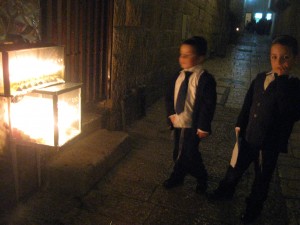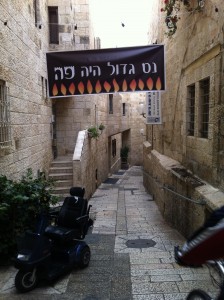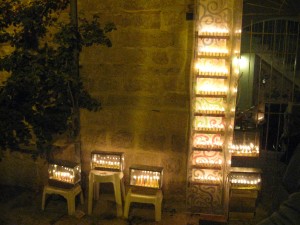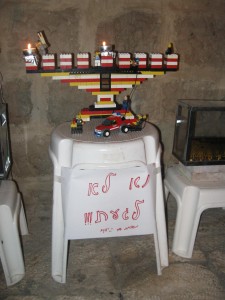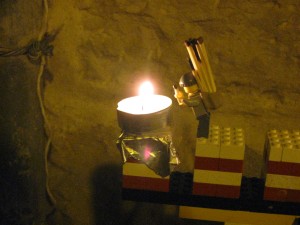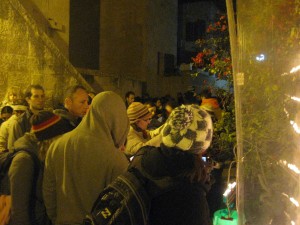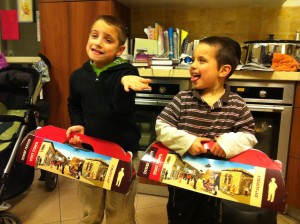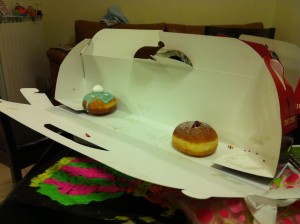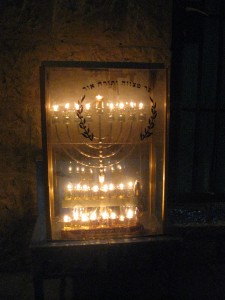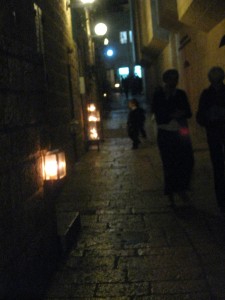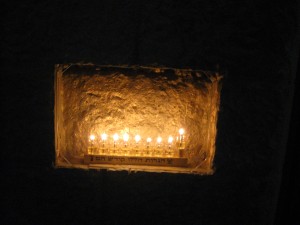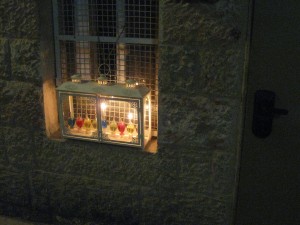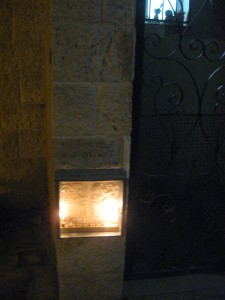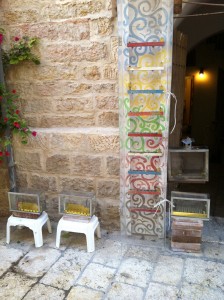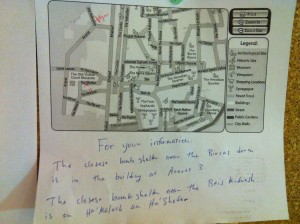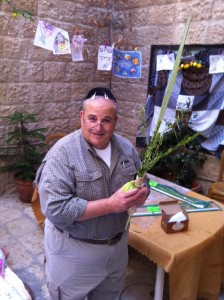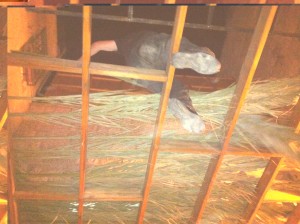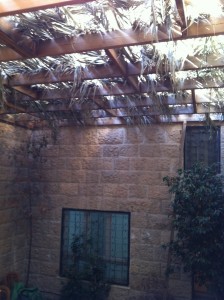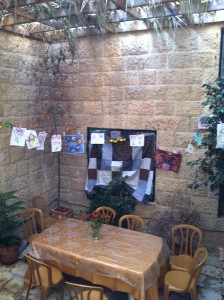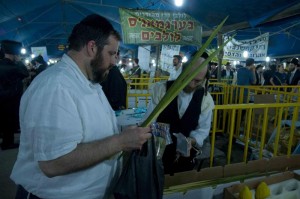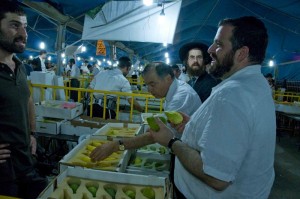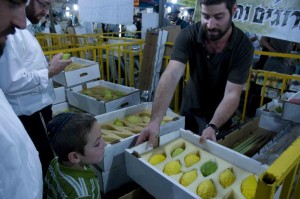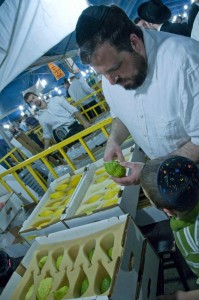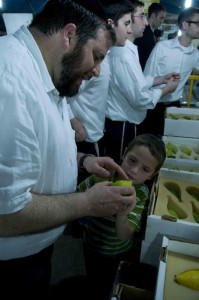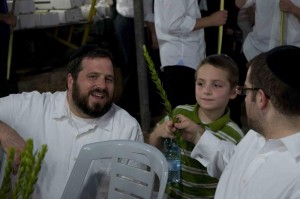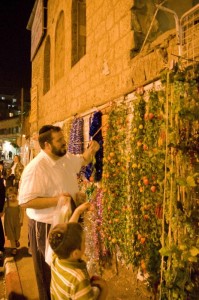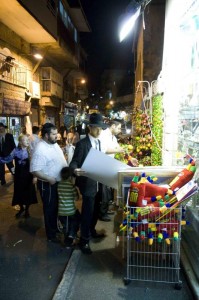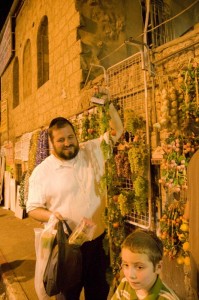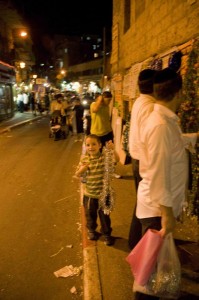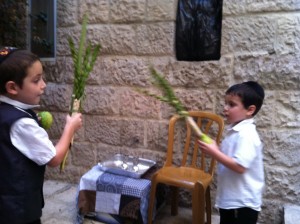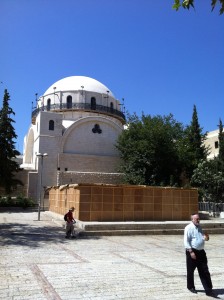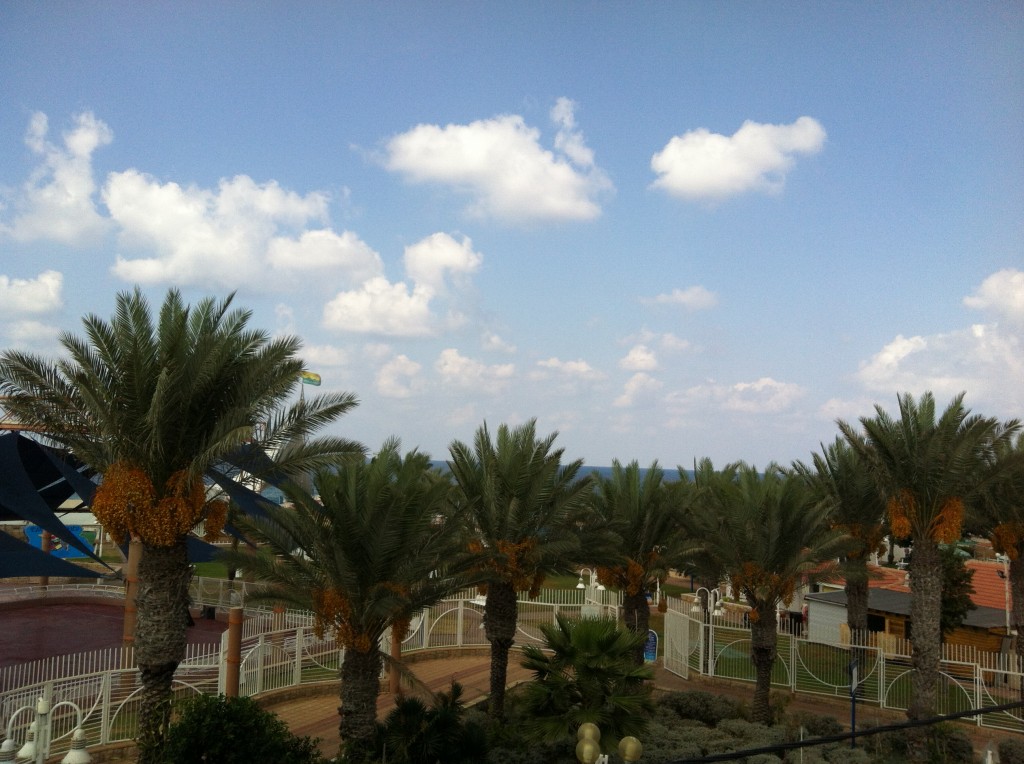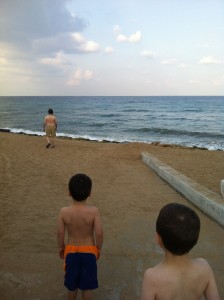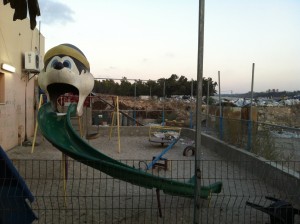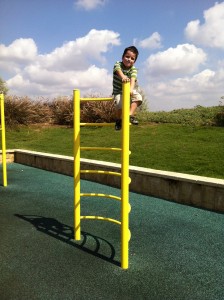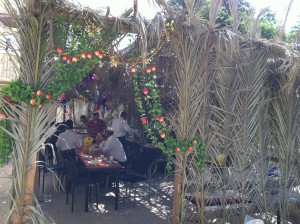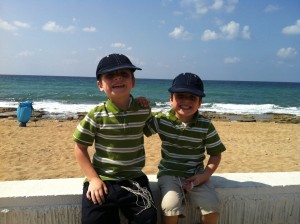It has already been nearly a month since Chanukah, but it was certainly an experience worth revisiting. (Not to mention that I’m finding blogging in a consistent and timely way to be much harder than it seems.) Growing up, I always dreamed of being in Israel for Chanukah.[1] I realized that dream last year, when we were here in Jerusalem for much of Chanukah. But living in the Rova this year took things to a whole new level.
In Israel, chanukiot are put outside the home when possible, in glass boxes made for that purpose.[2] In the Rova, some apartments have notches in the outside stone wall specifically made for chanukiot. Virtually every door has a chanukia outside of it, and many have several – the custom is for each child in the house to light one, in addition to the parents’, and multiple apartments in the same building may light at the same outside door, as was the case for us. The overall effect is stunning, with lines of boxes filled with light lining the cobbled streets of the Rova.
All of the holidays bring a surge in the already-numerous tourists here in the Rova, but Chanukah is unique. One major difference is that, for Chanukah, the overwhelming majority of visitors are (non-religious) Israelis. They come in every night to see the chanukiot, mostly in tour groups. As Chanukah goes on, the crowds keep getting bigger, and start coming earlier. Many come to see lighting itself, which happens here promptly at sunset.[3] Although we live on a normally-sleepy street, our building is a particularly popular Chanukah tourist destination. So, for example, when I stepped out to get ready to light on the seventh night, this is what was waiting for me:
Part of the reason our place is so popular is the large and lovely, hand-painted chanukia case of our neighbors, the Deutsches, and the Lego chanukiot of our other neighbors, the Shores. But they’re not the main reason. Debbie described it well in an email she wrote up for people back in Chicago:
As Chanukah comes to an end I just wanted to share a special part of our Chanukah here in the Old City. A number of years ago a neighbor of mine was part of an Ahavas Yisrael group[4] and trying to think of ideas to fulfill this mitzvah. Now, living in the Old City can feel like living in Disney Land with tourists constantly coming and going. Many folks have moved out of the Rova for this reason. But my beautiful neighbor chose to embrace this element of our neighborhood. During Chanukah most of the tourists are Israelis. She decided to set up a table in front of our building and hand out hot drinks.
It was a hit.
The kids in the building love it and have taken over setting up and manning the table. My kids think it is the best thing ever and Yitzi delighted in handing out candy we found in our cupboard.
The crowds build every night as people come to look at the chanukiot and have a warm treat. Tour groups come and my amazing neighbor brings them into her home and gives a little spiel on the holiday and offers for them to light (note: her husband works for Aish. Still it is amazing to give over one’s home night after night to large groups for this). The feeling is not kiruvy,[5] it is warm, happy, ahava. Everyone is smiling and when I peek out into the crowds, they thank me.
One man knocked on the door looking for medicine for his daughter who was not feeling well. I gave him what I had, and later the mother and daughter came to say thank you. It was so Israeli and lovely as we just felt connected.
It is amazing to me how much the intention of one’s acts can affect everyone. My street is mobbed for a week, which makes running errands and such more difficult. But the feeling is so happy and good, I don’t really mind. I am so inspired by being with happy Jews who are happy being together. Jews who don’t normally get to interact with each other.
I second everything Debbie said, with one caveat. It feels wonderful to “host” secular Israelis and celebrate this holiday together with them. The one wistful thing is the feeling that many are tourists not only to the Rova, but also to Chanukah. They take pictures of their kids next to other families’ chanukiot. They film others lighting the chanukia, saying the brachos, and singing Haneiros Halleilu and Maos Tzur.[6] They happily, but often sheepishly, wish us Chanukah sameach. I’m sure many do make Chanukah at home, but I’m also sure that many (more?) do not. I hope the light they brought back home from the Rova finds “kindling” there, as well.
When it comes to holiday foods, America and Israel seem to have opposite approaches regarding latkes and sufganiot. The emphasis in the U.S. is on the latkes, which are everywhere, while sufganiyot are available but not so prevalent. The converse is true here – latkes are not so easy to find, while sufganiyot are dominant. The bakeries in the Rova could barely keep up with the demand. During the tourist crush of the holiday, they were constantly cranking out trays and trays of a whole variety of sufganiyot (i.e., different fillings & toppings). There were even special boxes to carry them home.
In Chicago, “sufganiyot” really just means eating donuts at Chanukah time. They’re no different from the ones we eat all year. But, in Israel, donuts are pretty much only a Chanukah treat. Sure, you’ll see the occasional lonely box of Entenmann’s-style donuts at the makolet – usually adorned with the description “American-style” and a U.S. flag – but that’s about it. Israeli sufganiyot are much doughier than American donuts, and are almost exclusively the filled kind. I had a good time with the sufganiyot, but could’ve used some more latkes. Having no food processor (we’re trying not to buy so many appliances, which we’d wind up leaving here anyway) made it not so feasible to crank out our own, and no one seemed to be selling them.
I’ll wrap up this post with a gallery of some pictures of chanukiot around the Rova. But first is a 2-minute video someone made of Chanukah in Jerusalem. The initial :30 or so is shot in the Rova. I actually recognize several of these chanukiot (although ours did not make the cut, apparently). The next :30 or so was shot at Mamilla mall, which is just outside the Old City:
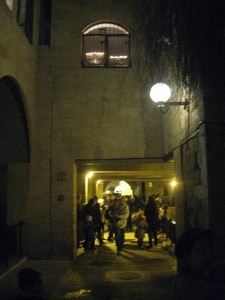
A friend of Shalom’s from school lives with his family in an apartment that overlooks a popular Rova thoroughfare – their chanukiot were in the video.
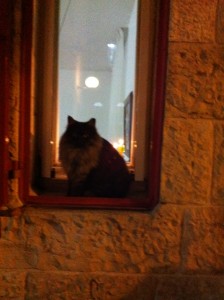
Like cats everywhere, the Jerusalem variety know when people are looking at a particular spot, and insert themselves accordingly.
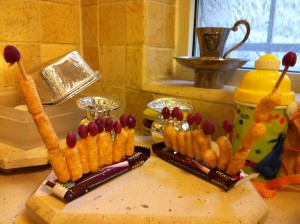
The traditional candy bar / bamba / jelly bean chanukiot.

